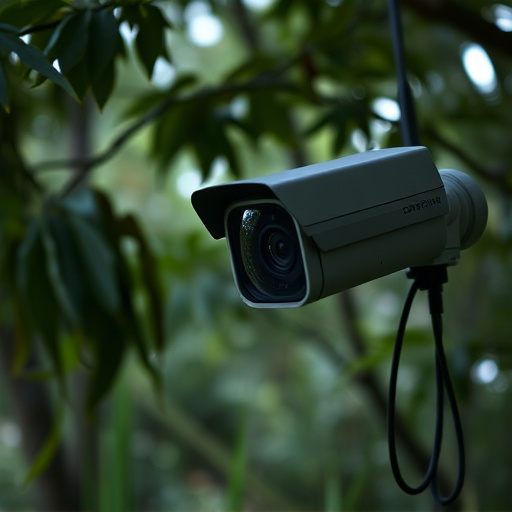In the digital age, privacy concerns surge with hidden microphones (bugs) used for audio surveillance, especially in devices like wireless nanny cams. A Wireless Nanny Cam Without Internet Connection offers a secure alternative, storing footage locally and operating independently without cloud risks. Advanced microphone bug detection technologies analyze sound patterns to identify concealed devices, enhancing home security without compromising privacy. Effective bug sweeping involves combining this tech with awareness: regular firmware updates, encrypted connections, clutter reduction, and privacy training for household members.
In today’s digital age, privacy concerns have led many homeowners to seek innovative solutions for secure monitoring. One such option gaining traction is the use of a wireless nanny cam without an internet connection, offering a discreet and effective way to detect potential bugs or microphones hidden within your home. This article explores microphone bug sweeping detection techniques, from understanding the basics to implementing safe practices, with a focus on advanced software and wireless surveillance technology for enhanced privacy protection.
- Understanding Microphone Bug Sweeping: The Basics
- Wireless Nanny Cam Without Internet: A Solution for Private Monitoring
- Detection Techniques: From Audio Analysis to Advanced Software
- Implementing Safe and Effective Bug Sweeping Practices at Home
Understanding Microphone Bug Sweeping: The Basics
Microphone bug sweeping, or audio surveillance, is a discreet method of monitoring conversations and sounds in an environment using hidden microphones. This practice has gained attention due to concerns over privacy invasion, particularly with the advent of advanced wireless technologies like the Wireless Nanny Cam Without Internet Connection. These devices can be easily concealed, making them effective tools for covert listening and recording.
The basic concept involves identifying and neutralizing hidden microphones placed in rooms or spaces to protect against unwanted eavesdropping. Technicians use specialized equipment to detect audio signals from these bugs, which may operate wirelessly and transmit data without the need for an internet connection. By understanding the fundamentals of microphone bug sweeping, individuals can take proactive measures to safeguard their privacy and create a secure home environment.
Wireless Nanny Cam Without Internet: A Solution for Private Monitoring
In today’s digital age, privacy and security are paramount, especially in homes where families seek peace of mind while ensuring their loved ones’ safety. A Wireless Nanny Cam Without Internet Connection offers a discreet and effective solution for private monitoring. This innovative device bypasses the need for constant internet connectivity, addressing one of the primary concerns with traditional smart home surveillance systems. By doing so, it enhances security without compromising privacy, as footage can be stored locally and accessed on-demand without any third-party data breaches.
The absence of an internet connection means that these nanny cams operate independently, reducing potential vulnerabilities associated with cloud storage and online streaming. This feature is particularly appealing to those who prioritize offline security measures and want to maintain control over their sensitive information. With local storage, homeowners can review recorded footage at their convenience without relying on continuous internet access, making it a practical choice for comprehensive home monitoring.
Detection Techniques: From Audio Analysis to Advanced Software
Modern microphone bug sweeping detection has evolved significantly, moving from traditional audio analysis to more advanced software-driven methods. One innovative approach involves utilizing wireless nanny cam devices that operate without an internet connection. These cameras, designed for discreet surveillance, can capture and analyze sound patterns in real time, alerting users to any suspicious noises or hidden microphones.
The software embedded in these devices employs sophisticated algorithms to detect subtle audio anomalies, such as directionality changes in sound or unusual frequency patterns, which could indicate the presence of a bug. This technology enables individuals to conduct thorough sweeps, ensuring their privacy and security, especially in sensitive environments where wireless connectivity might be limited but surveillance is paramount.
Implementing Safe and Effective Bug Sweeping Practices at Home
Implementing safe and effective bug sweeping practices at home involves a combination of technical tools and vigilant awareness. One powerful asset in this regard is a Wireless Nanny Cam Without Internet Connection. Since these devices operate independently, they don’t rely on constant network access, making them ideal for discreet and continuous monitoring. Position them strategically in areas of concern, such as bedrooms, offices, or common spaces, to deter potential intruders without raising suspicion.
Regularly updating firmware and using encrypted connections further strengthens your security posture. Additionally, maintain a clutter-free environment, as hidden microphones can be disguised among everyday objects. Train household members about privacy best practices, like not leaving electronics unattended with personal data enabled. By integrating these measures, you create a robust bug sweeping regime tailored to your home’s unique needs.
In light of the evolving landscape of privacy protection, understanding microphone bug sweeping detection techniques is paramount for homeowners. From the basics of understanding audio anomalies to leveraging advanced software, there are effective methods to detect hidden microphones. Moreover, integrating a wireless nanny cam without an internet connection offers an excellent solution for private monitoring, ensuring your home remains secure from unwanted eavesdropping. By adopting these safe and practical bug sweeping practices, individuals can safeguard their conversations and personal spaces effectively.
